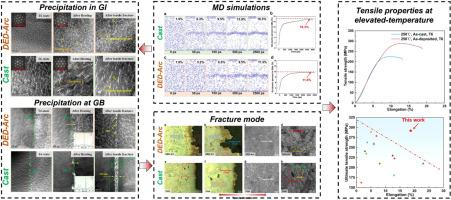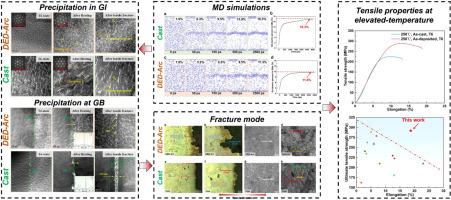增材制造Mg-Gd-Y合金的高温强度-塑性协同作用:热-力耦合下的动态析出演化和变形行为
IF 12.8
1区 材料科学
Q1 ENGINEERING, MECHANICAL
引用次数: 0
摘要
高温下的显著强度损失一直是镁合金扩展应用的巨大挑战之一。本文报道了用电弧直接能量沉积法制备的镁稀土(Mg-RE)合金的高温力学性能的显著提高。gd - 9gd - 3y -0.5 zr (GW93K)合金在250℃下的抗拉强度比铸态合金高近70 MPa,并具有良好的延展性。采用准原位方法研究了在简单热效应和热-力耦合作用下d -电弧合金和铸造合金的动态析出过程,并进行了对比研究。利用分子动力学(MD)模拟分析了稀土在d -电弧合金中的扩散。与铸造合金相比,d - arc合金在拉伸试验中表现出纳米级析出相,且在热-力耦合作用下,析出相的数密度显著提高。d -弧过程的残余位错和拉伸变形过程中形成的均匀分布位错阻碍了稀土溶质向晶界扩散,从而减少了晶界析出。抑制GBP和无析出区(PFZs)的存在降低了GBP处的应力集中,延迟了裂纹的萌生。系统比较了晶粒尺寸、织构和析出相等微观组织特征对变形模式的影响。因此,d -弧Mg-RE合金表现出优异的强度-塑性协同效应:250°C时的极限抗拉强度为291.9±7.3 MPa,伸长率为19.2±1.0%。这项研究可以为镁合金在高温等极端条件下的应用提供新的见解。本文章由计算机程序翻译,如有差异,请以英文原文为准。


Superior elevated-temperature strength-ductility synergy in an additive-manufactured Mg-Gd-Y alloy: Dynamic precipitation evolution and deformation behavior under thermal-mechanical coupling
Significant strength loss at elevated temperatures has always been one of the great challenges for the extended application of magnesium (Mg) alloys. This work reports an exceptional increase in the elevated-temperature mechanical properties of magnesium rare-earth (Mg-RE) alloys fabricated by direct energy deposition using electric arc (DED-Arc). The tensile strength at 250 °C of the DED-Arc Mg-9Gd-3Y-0.5Zr (GW93K) alloy is almost 70 MPa higher than that of the cast counterpart, accompanied by desirable ductility. A quasi-in situ approach was employed to investigate the dynamic precipitation evolution of both DED-Arc and cast alloys under simple thermal effect and thermal-mechanical coupling for a comparative study. Molecular dynamics (MD) simulations were utilized to analyze RE diffusion in DED-Arc alloys. Compared to cast alloys, DED-Arc alloys exhibit nano-scale precipitates with significantly higher number density under thermal-mechanical coupling during tensile test. The residual dislocations from the DED-Arc process and uniformly distributed dislocations formed during tensile deformation impeded RE solute diffusion toward grain boundaries (GBs), thereby reducing grain boundary precipitation (GBP). The inhibited GBP and absence of precipitation-free zones (PFZs) reduce stress concentration at GBs, delaying crack initiation. The effects of microstructural features including grain size, texture, and precipitates on deformation modes were systematically compared. Consequently, DED-Arc Mg-RE alloys demonstrate superior strength-ductility synergy: ultimate tensile strength: 291.9 ± 7.3 MPa and elongation: 19.2 ± 1.0 % at 250 °C. This research could provide new insights into the application of Mg alloys in extreme conditions such as elevated temperatures.
求助全文
通过发布文献求助,成功后即可免费获取论文全文。
去求助
来源期刊

International Journal of Plasticity
工程技术-材料科学:综合
CiteScore
15.30
自引率
26.50%
发文量
256
审稿时长
46 days
期刊介绍:
International Journal of Plasticity aims to present original research encompassing all facets of plastic deformation, damage, and fracture behavior in both isotropic and anisotropic solids. This includes exploring the thermodynamics of plasticity and fracture, continuum theory, and macroscopic as well as microscopic phenomena.
Topics of interest span the plastic behavior of single crystals and polycrystalline metals, ceramics, rocks, soils, composites, nanocrystalline and microelectronics materials, shape memory alloys, ferroelectric ceramics, thin films, and polymers. Additionally, the journal covers plasticity aspects of failure and fracture mechanics. Contributions involving significant experimental, numerical, or theoretical advancements that enhance the understanding of the plastic behavior of solids are particularly valued. Papers addressing the modeling of finite nonlinear elastic deformation, bearing similarities to the modeling of plastic deformation, are also welcomed.
 求助内容:
求助内容: 应助结果提醒方式:
应助结果提醒方式:


